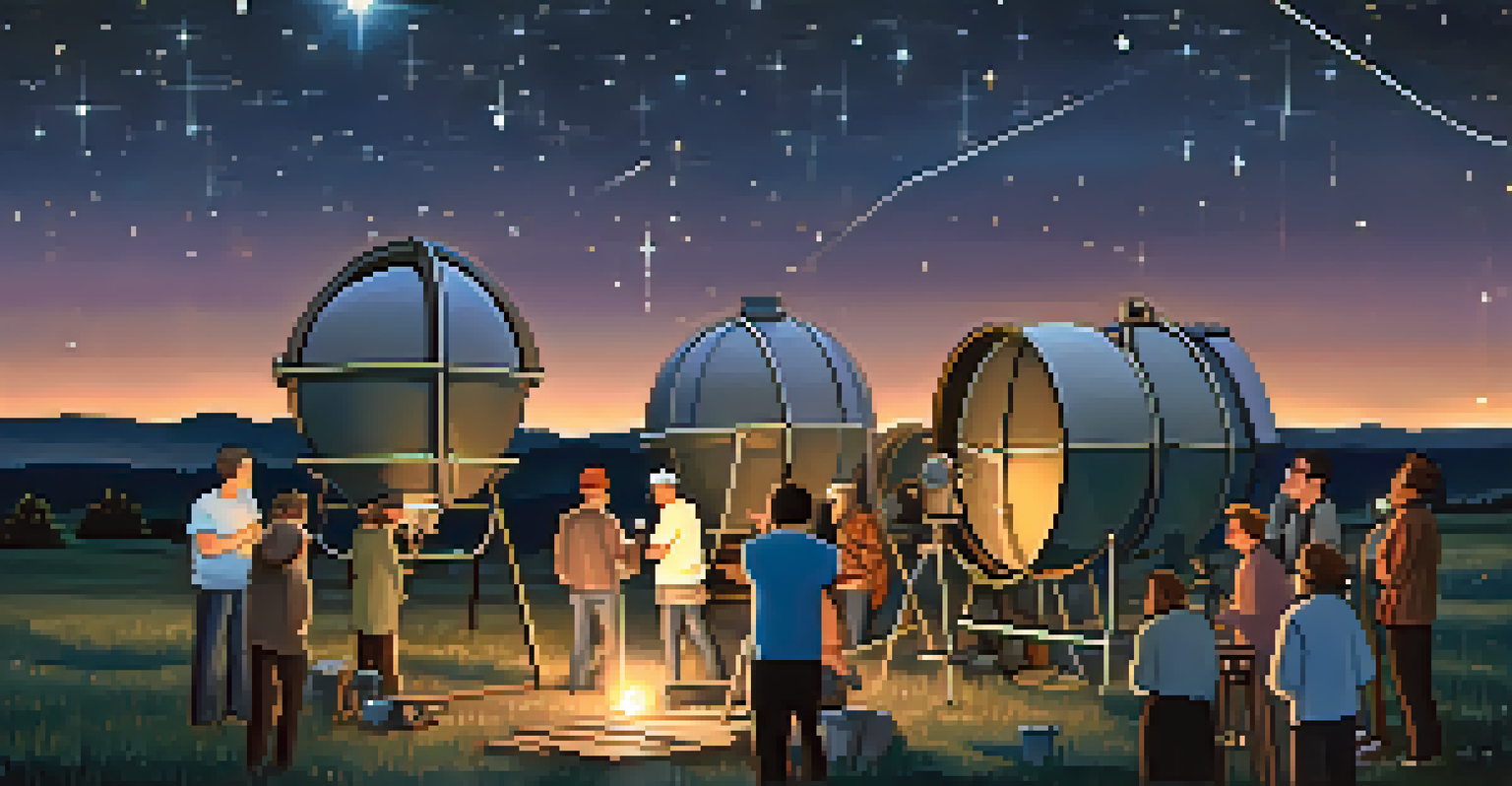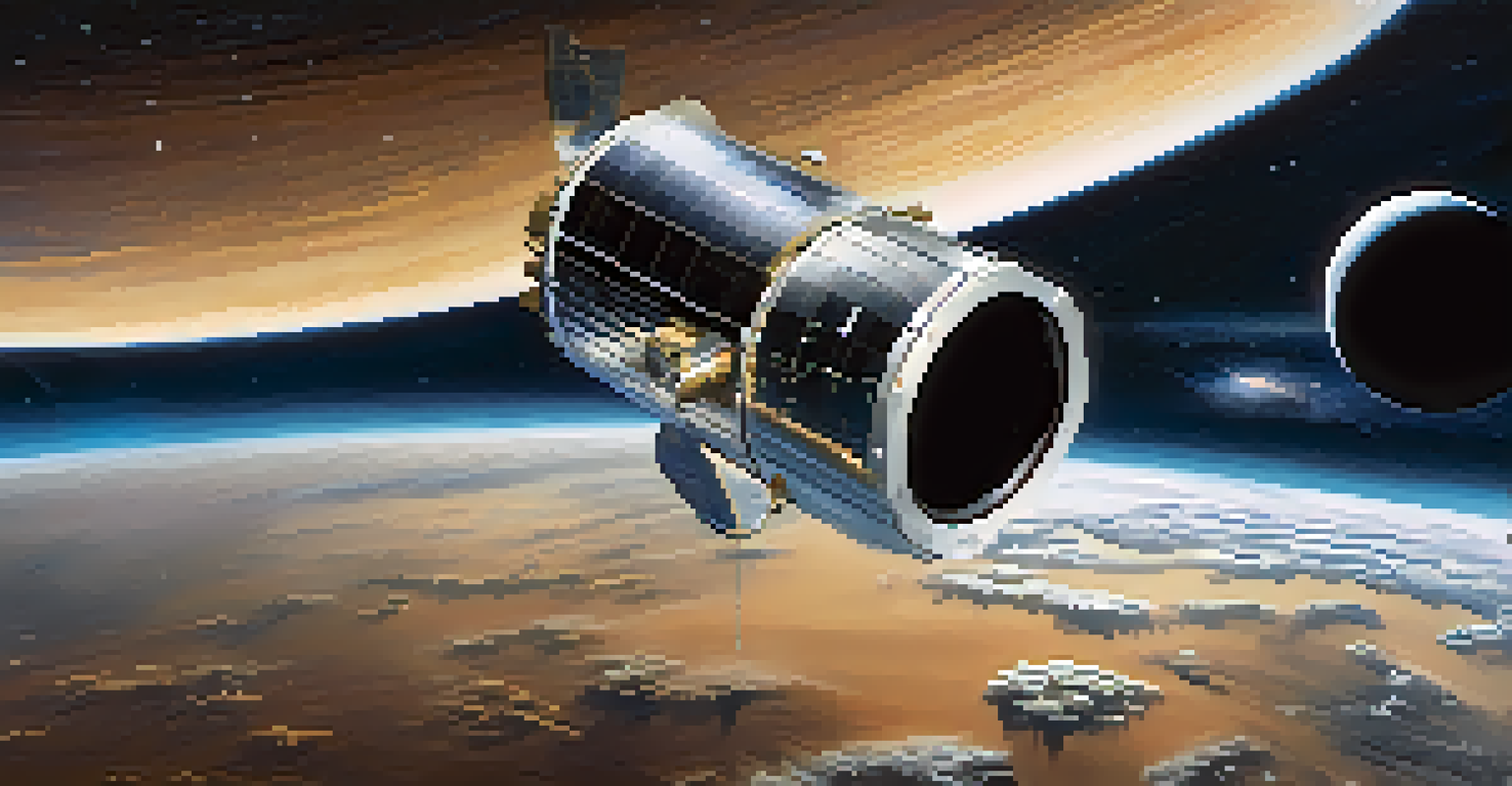The Role of Telescopes in Modern Astronomy Research

Understanding the Basic Function of Telescopes
Telescopes are remarkable instruments that allow us to observe distant celestial objects. At their core, they function by collecting and magnifying light from stars, planets, and galaxies. This capability enables astronomers to study objects that are billions of light-years away, effectively turning the night sky into a vast laboratory for exploration.
The universe is under no obligation to make sense to you.
There are two main types of telescopes: optical, which uses lenses or mirrors to capture visible light, and radio telescopes, which detect radio waves emitted by various cosmic phenomena. Each type serves a unique purpose, offering different insights into the universe's workings. For example, optical telescopes are great for examining the structure of galaxies, while radio telescopes can reveal the presence of black holes through their emissions.
Ultimately, telescopes are the bridge between us and the cosmos, transforming the faint light of distant stars into clear images and data. Without them, our knowledge of the universe would be limited to naked-eye observations, which only scratch the surface of what lies beyond our planet.
Advancements in Telescope Technology
Over the years, telescope technology has progressed at an astonishing rate. Innovations such as adaptive optics enhance image clarity by compensating for atmospheric disturbances, allowing astronomers to see finer details. This technology is akin to having a pair of glasses that adjust based on the weather, helping us focus on celestial objects that would otherwise appear blurred.

Space telescopes, like the Hubble Space Telescope, have revolutionized our understanding of the universe by operating above the Earth's atmosphere. This allows them to capture incredibly detailed images without the distortion caused by atmospheric interference. Think of it as moving from a crowded coffee shop to a quiet library—suddenly, everything is clearer and more focused.
Telescopes Unlock Cosmic Mysteries
Telescopes serve as vital tools that allow astronomers to observe distant celestial objects, providing insights into the universe's workings.
These advancements not only improve image quality but also expand the range of wavelengths we can observe. Infrared and ultraviolet telescopes, for instance, allow us to study the universe in entirely new ways, revealing phenomena that optical telescopes simply cannot detect. This multifaceted approach enriches our understanding and paints a more comprehensive picture of the cosmos.
The Role of Telescopes in Discovering Exoplanets
One of the most exciting applications of telescopes in modern astronomy is the search for exoplanets—planets outside our solar system. Telescopes equipped with specialized instruments can detect the subtle dimming of a star caused by a planet passing in front of it. This method, known as the transit method, has led to the discovery of thousands of exoplanets, many of which are located in the habitable zone where conditions might support life.
Astronomy compels the soul to look upward and leads us from this world to another.
In addition to the transit method, telescopes also utilize radial velocity measurements to infer the presence of exoplanets. By observing changes in a star's light spectrum, astronomers can detect the gravitational tug of an orbiting planet. This process is similar to tracking a dog on a leash; the dog's movements affect the person holding the leash, revealing its presence even from a distance.
The quest for exoplanets not only expands our understanding of planetary systems but also raises profound questions about life beyond Earth. Each new discovery adds a piece to the puzzle, encouraging us to explore the universe with renewed curiosity and hope.
Telescopes and the Study of Cosmic Evolution
Telescopes play a crucial role in our understanding of cosmic evolution—the history of the universe from its birth to the present day. By observing distant galaxies, astronomers can look back in time, as the light from these galaxies takes millions or even billions of years to reach us. This is akin to watching a movie that captures events long past, allowing us to piece together the universe's history frame by frame.
Through telescopic observations, scientists study the formation and evolution of galaxies, stars, and even the elements that make up our planet. For example, studying ancient light from the Big Bang helps researchers understand how the universe expanded and cooled over time. This cosmic backstory is essential for grasping our place in the universe.
Collaboration Fuels Astronomical Advances
Joint efforts among observatories and citizen scientists enhance our understanding of complex cosmic phenomena, leading to groundbreaking discoveries.
Moreover, telescopes help us investigate phenomena like supernovae and black holes, shedding light on the life cycles of stars and the mechanisms behind cosmic events. Each observation provides insight into the processes that shape the universe, fostering a deeper appreciation for the intricate tapestry of existence.
Collaborative Efforts in Astronomy
Modern astronomy is a collaborative effort, with telescopes serving as vital tools in this endeavor. Observatories around the world and in space often share data, allowing astronomers to combine their knowledge and resources. This collective approach is similar to a team of chefs working together in a kitchen, each bringing their unique skills to create a culinary masterpiece.
Joint projects like the Event Horizon Telescope, which produced the first image of a black hole, exemplify the power of collaboration. By connecting multiple telescopes across the globe, astronomers could achieve unprecedented resolution, demonstrating that teamwork can lead to groundbreaking discoveries. This synergy enhances our ability to study complex cosmic phenomena.
Furthermore, citizen science initiatives encourage amateur astronomers to contribute to ongoing research. Platforms that allow the public to analyze telescope data open the door for new discoveries, illustrating that curiosity knows no bounds. Together, professionals and enthusiasts alike are pushing the boundaries of what we know about the universe.
The Impact of Telescopes on Public Engagement
Telescopes not only advance scientific research but also play a significant role in public engagement with astronomy. Public observatories and planetariums offer opportunities for people to gaze at the stars, sparking interest and wonder in the cosmos. This hands-on experience can ignite a passion for science and exploration, making astronomy accessible to everyone.
Events like star parties, where enthusiasts gather to observe celestial events, foster a sense of community and shared discovery. Imagine a gathering of friends under a clear night sky, pointing out constellations and marveling at the beauty of the universe together. These moments create lasting memories and inspire future generations to explore the stars.
Future Tech Will Revolutionize Astronomy
Innovations like the James Webb Space Telescope and advancements in AI promise to uncover more mysteries of the universe and deepen our understanding of existence.
Moreover, social media and online platforms enable astronomers to share their findings and engage with the public in real-time. Live streams of telescope observations during significant astronomical events can captivate audiences worldwide, making science more relatable and exciting. This enhanced communication helps bridge the gap between complex research and public understanding.
The Future of Telescopes in Astronomy
As we look ahead, the future of telescopes in astronomy is incredibly promising. Upcoming projects like the James Webb Space Telescope are set to revolutionize our understanding of the universe, offering unprecedented capabilities to observe the first galaxies formed after the Big Bang. This next-generation telescope will act like a time machine, allowing us to peer into the universe's infancy.
Additionally, advancements in artificial intelligence and machine learning are enhancing telescope data analysis. These technologies can sift through vast amounts of data, identifying patterns and anomalies much faster than humanly possible. It's as if we have a super-smart assistant that helps us find the hidden gems in astronomical data.

The continued evolution of telescope technology ensures that we will uncover more mysteries of the universe. With every new advancement, we come closer to answering fundamental questions about our existence, the nature of dark matter, and the possibility of life beyond Earth. The journey of discovery is ongoing, and telescopes will remain at the forefront of this exciting exploration.